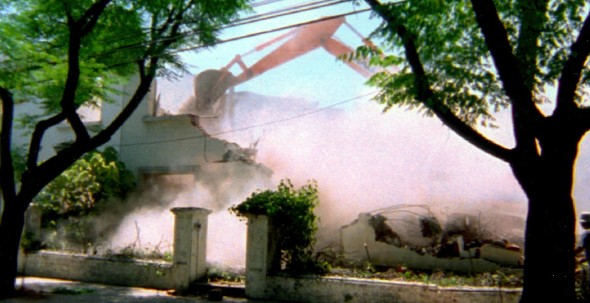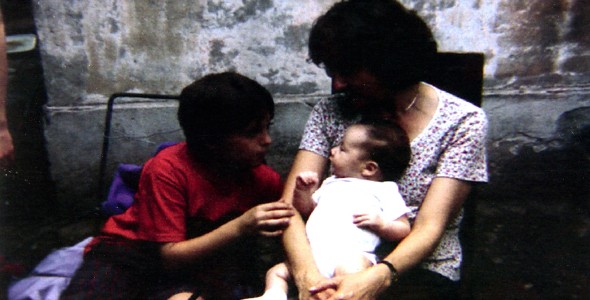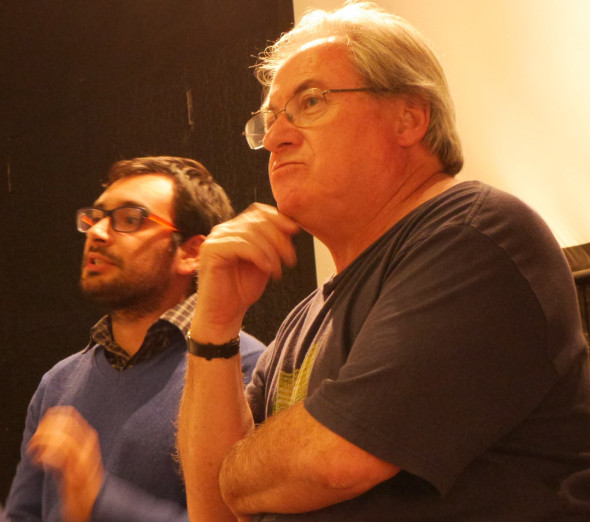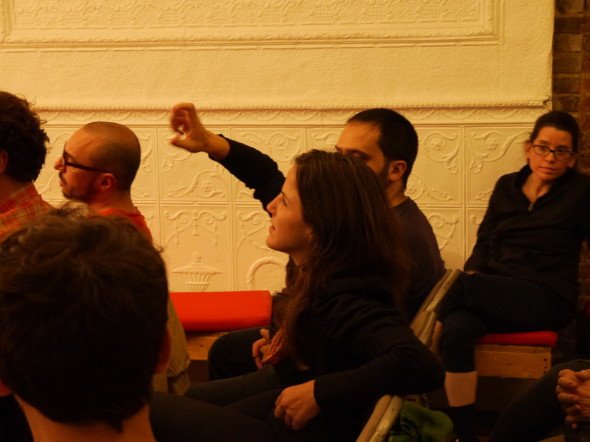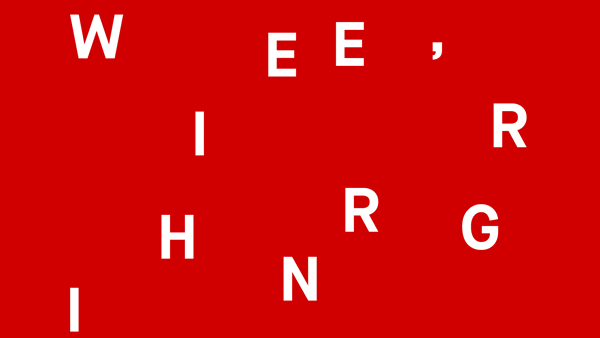On September 15th, scholar and critic José Miguel Palacios spoke with filmmaker Ignacio Agüero after a screening of Under Construction (2000) at UnionDocs.
The film spends time with a man who lives through the demolition of the house next door and the construction of a new building in the same place, all in a two year period. Under Construction is about the passage of time, and how we construct our inner lives through our connections to our physical surroundings.
In a discussion with the audience, Agüero delves into the intricacies of creating a film that is as much about the tearing-down and building-up of a physical space as it is about the inner life of his protagonist, Guillermo. He speaks of the importance of balancing the interior and exterior life of spaces in transition through film.
José Miguel Palacios: For tonight’s screening we have Ignacio’s Under Construction, a really important film made in Chile in the late 1990’s and early 2000’s, to really capture the moment of transition to democracy, when there was a very brutal implementation and advancement of the neoliberal model that was installed by the military dictatorship. We have Ignacio here with us and he’s going to speak in Spanish and I’ll be translating, though he understands English perfectly.
Could you start by telling us about the origin of this film for you?
Ignacio Agüero: The origin is very clear, and it begins when I used to travel everyday—I lived in Santiago near the Cordillera [Province], up in the hills, and I used to go downtown to take my kids to school—so I’d see the change in the urban landscape. Sometimes I’d see a house on Thursday and then the next day it wasn’t there.
I thought someone was transforming the images with which I lived in my everyday life, and that this was a possible way to cause madness. The value of the land had been raised, so real estate companies bought the land to build these buildings. I wanted to film these houses that were going to be demolished as a way to retain these images. That’s the origin of the film.
JMP: How did you get to Guillermo, the main character? There is this beautiful moment in the film when we don’t know if you find him, or if he has found you.
IA: The two of us found ourselves in the same process here. I was looking for him and he was waiting for someone like me to come along. We were in a common battle against this generalized demolition process. I was filming different demolitions without thinking I was going to make a film out of it. I did that for a long time. But after having filmed many of these houses I decided I had to make a film about it. Then I decided to focus on one particular place, a small space. I had to summarize the city in this particular location.
JMP: Could you tell us a bit more about that in terms of the process of shooting? How long was it? There are these moments, again, where you see the character make references like this: “it’s been two months since we’ve seen you”, and you ask what has happened and he tells you what happened in the meantime. Maybe you could tie that in with this idea you mentioned about the space and the particular location—Ignacio has been insisting that all his films are about places.
IA: I try to observe a particular place for a period of time that is never less than one year. I place a bet assuming that something is going to happen. It’s not a film about something that I know is going to happen but something I hope will happen. Not because I wish for something to happen, but because I know something will happen, and it will change that space. It ends in this gaze of the neighbor who is now in the new building looking at my protagonist from above, as the winner of this non-explicit battle.
So the production process is one of exploration in which interesting things happen because you try to find different ways of relating different things, of putting them in relation. What I like about the film is that it is my own process of discovering the transformation of a space. What the audience sees is not something that is straightforward from the beginning but a process of discovery.
JMP: So we will take questions from the audience now.
Audience Member 1: One of the longest scenes, that was really interesting to me was about the workers traveling very early in the morning going to work—going from one place to another, before dawn. You spend a lot of time on this. I was wondering what you grappled with in the editing process. It seemed like you were trying to figure out how to put the workers in the film. I was wondering why, in this exploratory way that you shot it, and how that long scene happened? Did you think of bringing the workers in as characters? It seemed like you wanted to. I’m curious about how you went about editing that.
IA: The film included everyone, or almost everyone, that is connected to this space. The workers are directly related to this space because they are the ones that make it grow. I was interested in knowing who these people were and where they came from, and I knew they were coming from very far away in the city. These are people who are not concerned about the larger issues maybe, but they are concerned about having a job and making money. In the editing process I gave a lot of thought to how long this sequence would last. Maybe I would have kept my audience more interested if this scene was shorter, but I couldn’t betray the long trip that the workers made everyday. If you see that trip, without a rush, it’s very interesting.
Audience Member 2: How much time did you have in post-production after you completed filming?
IA: A year and a half, a year or so with the editing and then another three or four months of technical processes.
Audience Member 3: How did you see the professor’s discourse on natural selection in relation to the subject matter?
IA: It’s a great question. It’s the point of view of my protagonist and I just let it in the film. When he speaks about this he makes the connection with what he teaches in his university classes, but the film connects it to what he is experiencing in his life in this particular moment. That’s what interests me in making a film: to achieve this space that contains all these different images and to make them come together.
Audience Member 4: The question is posed in the film: who is this person who’d want to live in the building that costs so much to live in? I’m wondering what the answer is. Because there is this kind of confrontation between the two men who look, in a way, not so different. What is the cultural difference between these people?
IA: There are not really great differences between the two people. The real difference is what has been established on one side of the wall from the other. On one side you have a space that is filled with culture and tradition, and on the other side is a space that has been ruled by profit. But the people are just two people who need a place to live. The real different people are the workers because they are marginalized from this, which is expressed in the urban landscape of the city because you see them coming from the margins.
Audience Member 5: I am from Chile, although I haven’t lived there in a long time. I have two things to say. The constant turn over and role of construction, from the 1900’s to the 1960’s, into the high rises is not only a product of the explosive economy and its underlying inequality of the distribution of wealth in the country, but it is also a metaphor for the destruction of memory. The biologist, the university professor, says this very clearly in the film: “they are destroying my infancy, my childhood”. One of the subtitles of the film says “the house where I grew up is no longer there”. The other comment is a totally personal appreciation. That final image with the guy up in the balcony looking down at the biologist in this green environment…it is quite a contrast between the new classes in Chile that are a product of precisely the very backward redistribution of income in the country. As a Chilean who comes from the working class, I can see in the gaze of the guy who is up there, the typical dismissiveness of ascending layers of the upper crust in Chile. And a certain harshness and coldness. Whereas the university professor is earthy, grounded, green in the larger sense. But the class issue is even more powerful to me in that dismissive gaze.
IA: That is a great remark, thank you.
Audience Member 6: I’m still partly in a mood of being eaten alive by that machine that is like a monster clawing at and destroying environments, even as it prepares to build them. That contradiction is so interesting. It seems to me that the contrast between what the biologist says in his academic classroom about the flourishing of new species in a new habitat is in the same kind of contradiction and conflict with the feelings that he has that are generated by the images in the film of the destructiveness of what we think of as the natural environment. I know that some of the academic discourses about how we are talking about eviction or extermination, when we talk about natural selection, and evolution and all of that was evoked for me as a troubling series of images and concepts in the film, very powerfully.
IA: In the end there is a fact and that is what we see in the film. That fact is regardless of the ideas of the character, the biologist. The fact is that the destruction of the city is for the profiteering interests of a few. So in this idea of natural selection, those who survive are the ones who do not face in opposition to what they do. The destruction takes place because it is allowed to take place.
Audience Member 7: I have to ask a question about the professor’s heart, because technology is allowing him to live longer and survive longer, so I’m wondering if you included that to also show that maybe there’s some hope and that biology maybe would have failed him, but that what they’ve built inside him is going to keep him alive longer. I’m wondering if there is some hope that you were trying to show as the filmmaker that the new building, that new technologies, aren’t all on the bad side, by including that.
IA: That is your reading, and that’s very well. But these films are made for each audience to find their own reading too. But I don’t think so. His surgery is something that did happen, so it’s a part of the movie, but there is no purpose of saying something specific about it. It is of course connected to everything else that happens in the film, and we can make different associations with that, because he is someone who has not been destroyed.
Audience Member 8: You said that you were fairly confident that by looking at one place for a year you would see a change. What was so profound to me about the film is the change we see in the professor. Were you confident that you would see a change in him? Or were you expecting it, was it part of your intention or hope as a filmmaker to bring that out, to have that happen, to parallel the construction? Or did you just have good luck?
IA: It’s produced good luck. The good luck I had was in having found this biologist. I found him some time after beginning the shooting process. So this is tied to the idea we were talking about how my encounter with the biologist is produced. It is a necessary encounter. This is how it happened: I was in that street and I saw the sign that said ‘for sale’, and then I saw him at the edges of the house and we both looked at each other and we were at a distance of about 100 feet. And so in that shared gaze, that is the film. In a way the film allows this because my working method is one that allows the emergence of this encounter.
Audience Member 9: How did you develop your relationship with the professor? It feels like the conversations are very organic. How much did you talk with him off-camera? How deep a friendship did you form with him?
IA: We had a very good relationship. The day after we exchanged gazes in the street, I went to look at his place as a potential buyer. I went to see the house, I was able to see the whole house, and to learn a little bit more about him. The day after that I went back again and I came with the written project and I explained to him that I was not a buyer, but a filmmaker. He liked that very much, and he opened the doors of his home for me and welcomed me. I could go there and shoot any time of day, regardless if he was there or not. Even when his mother died he called and told me I could come inside and film where his mother was lying dead, but I didn’t do that because it was not necessary. I had one really good conversation with him, but a silent one, because the sound operator lost the sound. It is a conversation without purpose for the film, but rather a conversation between two neighbors, between two citizens. However, he still withheld things from me. He had this place in the backyard where he kept the remains of things, he wasn’t specific about it. One day after the shoot was over we had a barbeque, and he took me to this place and opened it up and shows me this collection of bats that he inherited from his father. I think this would have enriched the film to have included that. As would have been the inclusion of different sex scenes between all these different insects and animals. (Laughter)
Audience Member 5: I’d like to make another comment. I keep being bothered by the notion of natural selection in the film because what happened in Chile was an establishment of an economic lab that allowed the most raw and savage economic Darwinism, and therefore I would call it unnatural selection because it was a product of the greed and the total freedom with which economic forces were turned loose. This is part of what I see in the high-rise scene mixed in this place with the gaze of the upper class.
Audience Member 10: I really enjoyed the film and I was curious how this happens in Greece or in other countries around the world—and I can relate to it in this neighborhood, in Williamsburg, with the gentrification process, and also in Berlin. Do you see this everywhere you go, in the big urban centers?
IA: Yes, so this in fact happens everywhere and audiences tell me they can relate to it, that it is connected to places in which they live or their neighborhoods. I think even if you, as a viewer were not experiencing something similar, the film can still speak to you because it talks about all these larger issues too: urbanity, change, and architecture.
Audience Member 11: I had a comment. I enjoyed the film. It was great. It has a lot of very existential topics that go beyond what’s actually going on. But I discovered also a universal truth through the film. Two things: there is the model apartment, right? And it has the tall mirror that every model apartment has but nobody ever really uses it in their real home. That’s one thing I noted and that brought me to Latin America: the whole thing about the homes, the entire buildings coming down and they’re trying to fight the dust. Only in Latin America!
Audience Member 12 (translated): How did you choose the ending of the film, and why didn’t you wait for the actual sale of the house to happen?
IA: I wanted to continue filming because I wanted to film the people who were coming to live in these buildings. This would have taken me to a completely new direction in the film. I’m still interested by this question of who are the ones who come to live here. In secret, I had the hope that the house of Guillermo was going to be demolished. (Laughter) And it was, but a long time afterwards. I had to put an end to the film due to bureaucracies and funding issues associated with it, contracts, etc. But I would have loved to continue the film in that direction. This is a very interesting question for me because when you have a narrative film, a fiction film, you have the rhythm of beginning, middle, end. In the end they are happy, and they are in love, and they get married. (Laughter) But in a documentary you don’t really have a reason for any particular ending. So in the case of this film I enforced this ending which is their shared gaze. In which the look of the man in the building is a documentary image, but the one of Guillermo who is looking up, is a fiction. That closes the film, and perhaps this conversation.

